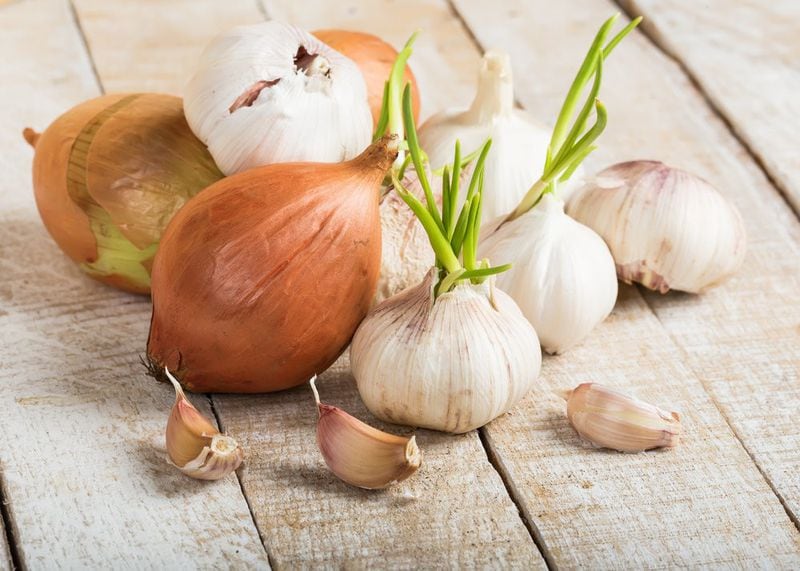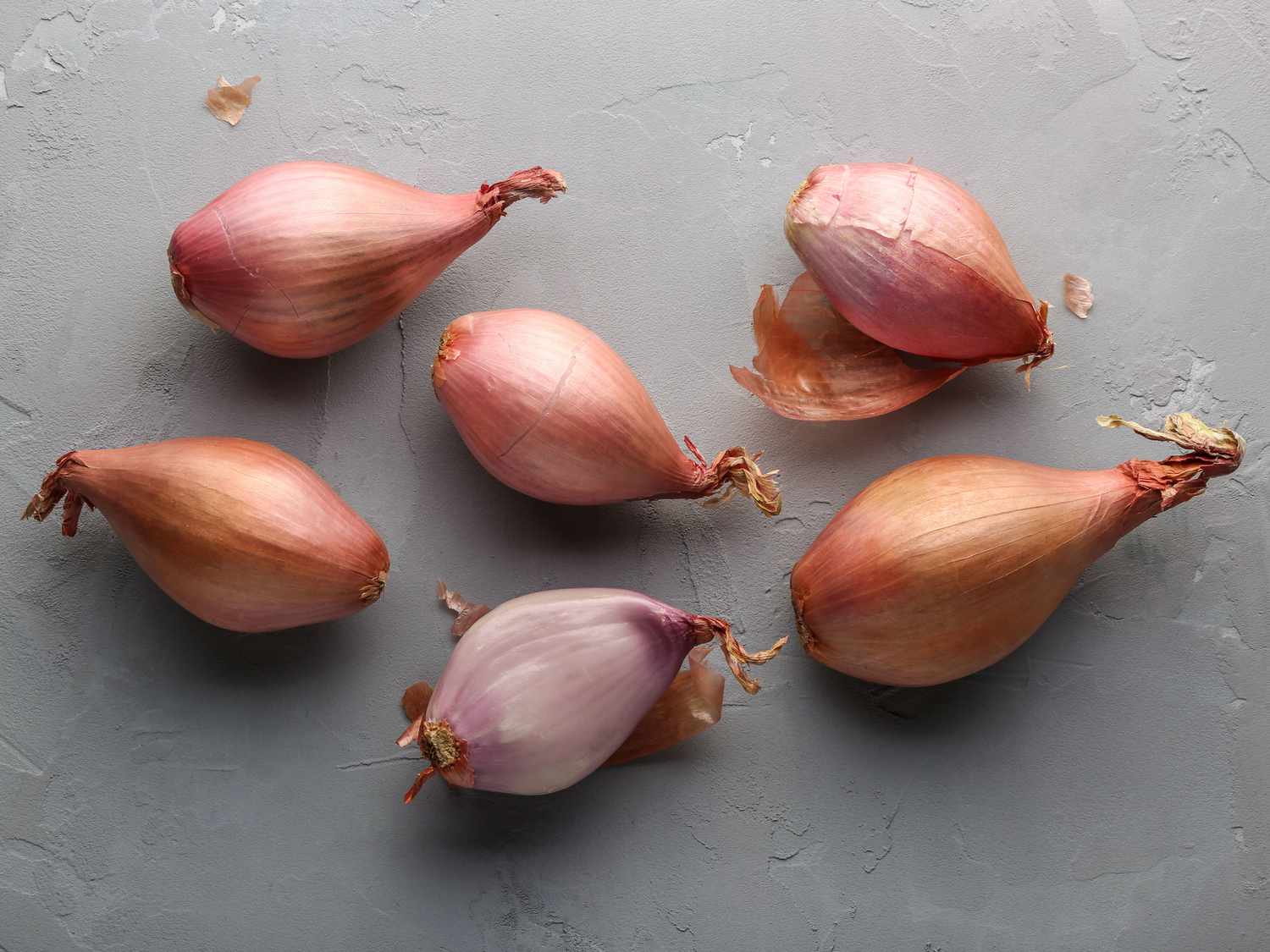Introduction To Garlic And Shallots

Garlic and shallots are aromatic bulbs that have been utilized in culinary traditions around the world for centuries. While both belong to the allium family, they possess distinct characteristics that set them apart. Garlic, with its pungent and bold flavor, adds depth and complexity to dishes. Shallots, on the other hand, have a milder flavor, making them a versatile ingredient in various recipes. Whether it’s the strong and distinct taste of garlic or the delicate and aromatic nature of shallots, these bulbs bring their own unique profiles to enhance the flavors of any dish.
1 Garlic Overview
Garlic is a versatile and aromatic bulb that is widely used in culinary traditions across the globe. It is known for its distinct and pungent flavor, which adds depth and complexity to dishes. Garlic cloves are typically larger and have a round bulbous shape. Each bulb is made up of several individual cloves, which are peeled before use. Garlic is a staple ingredient in various cuisines and can be used in both raw and cooked forms. Its powerful flavor and aroma make it an essential ingredient in many savory dishes, sauces, marinades, and dressings.
2 Shallots Overview
Shallots, another member of the allium family, are smaller and have an elongated tapered shape compared to garlic cloves. They have a milder and sweeter flavor profile compared to garlic. Shallots also have a brown, reddish, or off-white skin with multiple cloves that are typically clustered together. Their texture is softer and their taste is more delicate than garlic. Shallots are commonly used in French cuisine and are a popular choice for sautéing, roasting, and making sauces and dressings. Their unique flavor adds a subtle yet distinct taste to dishes.
Nutritional Value And Health Benefits

Shallots and garlic offer not only unique flavors but also valuable nutritional benefits. Both are rich in vitamins and minerals such as vitamin C and manganese, which contribute to a healthy immune system and antioxidant defense. Garlic, in particular, is known for its high levels of antioxidants that can help reduce oxidative stress in the body. Additionally, shallots are packed with beneficial compounds like quercetin and anthocyanins, which have anti-inflammatory properties and can support overall immune health. Incorporating both shallots and garlic into your diet can contribute to a well-rounded and nutritious meal plan.
1 Nutritional Comparison: Garlic Vs Shallots
Garlic and shallots are both nutritional powerhouses, but they have some differences in their nutrient profiles. Garlic is higher in calories and carbohydrates compared to shallots. However, garlic contains more vitamins and minerals, such as vitamin B6, vitamin C, and manganese, which contribute to a healthy immune system and antioxidant defense. On the other hand, shallots have higher amounts of potassium and iron. Both garlic and shallots are low in fat and cholesterol. Adding both of these flavorful bulbs to your diet can provide a variety of essential nutrients and health benefits.
2 Health Benefits Of Consuming Garlic And Shallots
Garlic and shallots offer a range of health benefits when consumed regularly. Both bulbs contain compounds with powerful antioxidant and anti-inflammatory properties, which can help reduce the risk of chronic diseases such as heart disease and certain types of cancer. Additionally, garlic and shallots have been shown to support immune function, improve digestion, and promote healthy blood sugar levels. The sulfur-containing compounds found in these aromatic bulbs also have antimicrobial properties, aiding in the prevention of infections. Incorporating garlic and shallots into your diet can be a delicious way to enhance your overall health and well-being.
Culinary Uses And Flavor Profiles

Garlic and shallots are both versatile ingredients that are widely used in various cuisines around the world. Garlic is known for its bold and intense flavor, adding a strong and pungent taste to dishes. It is commonly used in savory dishes such as pasta, stir-fries, and marinades. Shallots, on the other hand, have a milder and sweeter taste with hints of herbal undertones. Their flavor profile is more delicate than garlic, making them perfect for dishes with a subtler and more nuanced taste. Shallots are often used in sauces, dressings, and vinaigrettes to enhance the overall flavor. Incorporating either garlic or shallots into your culinary creations can elevate the taste and depth of your dishes.
1 Culinary Application Of Garlic
Garlic is a staple ingredient in many cuisines around the world, known for its bold and intense flavor. Its culinary uses are vast, making it a versatile ingredient in various dishes. Garlic can be used both cooked and raw, adding depth and complexity to soups, stews, sauces, and marinades. It is commonly sautéed with onions as a base for many recipes. Additionally, garlic can be minced and incorporated into dressings, spreads, and dips, giving them a distinct and savory taste. Its versatility and strong flavor make garlic a go-to ingredient for enhancing the overall taste of dishes.
2 Culinary Application Of Shallots
Shallots are highly versatile in the culinary world, adding a delicate and gentle flavor to dishes. They can be used both cooked and raw, enhancing the taste of a wide range of recipes. Shallots are often chopped and sautéed to create a subtle and sweet base for soups, sauces, and stir-fries. They can also be caramelized to bring out their natural sweetness and used as a topping for meats or mixed into dressings and vinaigrettes. Shallots can elevate the flavor profile of salads, pastas, and even seafood dishes, making them a valuable ingredient in the kitchen.
Growing And Storing Garlic And Shallots

Growing and storing garlic and shallots is relatively easy and can be done by following a few simple steps.
To grow garlic and shallots, start by separating the bulbs into individual cloves. Plant them in a nutrient-rich, loose soil that drains well. Ensure they receive adequate sunlight and water regularly. Garlic and shallots can be grown in pots or in the garden, depending on your preference.
When it comes to storing garlic and shallots, it’s important to keep them in a cool and dry place. Avoid storing them in a humid environment as it can cause them to spoil. Both garlic and shallots can be stored for several months if properly dried and stored in a well-ventilated area.
By following these tips, you can enjoy a fresh supply of garlic and shallots throughout the year.
1 Tips For Growing Garlic And Shallots
When it comes to growing garlic and shallots, there are a few tips to keep in mind. First, choose a sunny spot in your garden or use pots with well-draining soil. Plant the individual cloves of garlic or shallots about 4-6 inches apart and 1-2 inches deep. Water regularly to keep the soil moist but not waterlogged. Mulching around the plants can help conserve moisture and suppress weeds. As the plants grow, remove any flower stalks to promote bulb development. Harvest the bulbs when the tops start to yellow and dry, then store them in a cool, dry place for future use.
2 Proper Storage Techniques For Garlic And Shallots
Proper storage techniques are crucial for ensuring the long-term freshness and flavor of garlic and shallots. For both garlic and shallots, it is essential to store them in a cool, dry place. Avoid storing them in the refrigerator, as the moisture can cause them to rot. Instead, store them in a well-ventilated area, such as a pantry or a mesh bag hung in a cool room. It is also important to keep garlic and shallots away from direct sunlight, as exposure can cause them to sprout or become bitter. By following these storage techniques, you can extend the shelf life of your garlic and shallots and enjoy their aromatic flavors for longer.
Flavor Profile And Aroma

Both garlic and shallots contribute distinct flavors and aromas to dishes, making them key ingredients in various cuisines. Garlic has a bold and pungent flavor with a characteristic sharpness that can be overpowering when used excessively. Its aroma is strong and savory, enhancing the overall taste of dishes. On the other hand, shallots offer a more delicate flavor, with a subtle sweetness and mild onion-like taste. The aroma of shallots is more refined and subtle, adding depth and complexity to dishes without overpowering other ingredients. Ultimately, the choice between garlic and shallots depends on personal preferences and the desired flavor profile of the dish.
1 Aroma Comparison: Garlic Vs Shallots
When it comes to aroma, garlic and shallots have their own unique scents that can greatly impact the overall flavor of a dish. Garlic has a strong and pungent aroma that fills the kitchen with its savory fragrance. It can add a bold and robust scent to dishes, especially when cooked. Shallots, on the other hand, emit a more delicate and subtle aroma. The fragrance of shallots is sweet and onion-like, providing a pleasant and inviting scent to dishes. So whether you prefer a strong and robust aroma or a delicate and sweet fragrance, both garlic and shallots have their own distinct aromatic qualities.
2 Impact On Different Cuisines Worldwide
Garlic and shallots have a significant impact on different cuisines worldwide. Their flavorful characteristics make them essential ingredients in various culinary traditions. In Mediterranean cuisine, garlic is commonly used in dishes like pasta, sauces, and stews, adding a robust and savory flavor. Shallots, on the other hand, are prominent in French cuisine, where they are often used in sauces and dressings, bringing a delicate and sweet taste. Additionally, both garlic and shallots play key roles in Asian cuisine, providing their distinct aromas and enhancing the overall taste of dishes such as stir-fries and curries. The versatility and unique flavors of garlic and shallots make them indispensable in global culinary experiences.
Conclusion

In conclusion, the comparison between garlic and shallots reveals their distinct characteristics and versatile uses in the culinary world. While both belong to the Allium family, shallots offer a delicate and sweet flavor, making them a suitable choice as a substitute for onions. Garlic, on the other hand, provides a pungent kick and robust flavor to dishes. The choice between garlic and shallots depends on personal preferences and the specific requirements of a recipe. Both ingredients contribute depth and complexity to various cuisines worldwide, enhancing the overall taste and aroma of dishes.
1 Summary Of Garlic And Shallots Comparison
Garlic and shallots, both members of the Allium family, offer distinct flavors and uses in the culinary world. Shallots provide a delicate and sweet taste, making them a great substitute for onions. On the other hand, garlic adds a robust and pungent flavor to dishes. While shallots have an elongated shape with multiple pinkish-brown layers, garlic consists of round cloves enclosed in papery casings. Shallot bulbs are larger and sweeter compared to the varying sizes and potency of garlic cloves. Ultimately, the choice between garlic and shallots depends on personal preference and recipe requirements.
2 Final Thoughts On Choosing Between Garlic And Shallots
When it comes to choosing between garlic and shallots, it ultimately depends on personal preference and the specific recipe requirements. Garlic offers a robust and pungent flavor, while shallots provide a delicate and sweet taste. If you’re looking to add depth and complexity to your dishes, garlic is a great choice. On the other hand, if you want a milder and slightly sweeter flavor, shallots are the way to go. Both garlic and shallots have their own unique qualities and can elevate the taste of your meals, so feel free to experiment and find your favorite!
FAQ About Garlic Vs Shallots: Aromatic Bulbs Compared
Q: What are the main differences between garlic and shallots?
A: Garlic has a more pungent and distinctive flavor compared to the milder and sweeter taste of shallots. Shallots are composed of multiple cloves like garlic but have a different texture and taste profile.
Q: Can garlic be a suitable substitute for shallots in cooking?
A: While garlic can provide a similar aromatic essence in dishes, shallots offer a unique flavor profile that cannot be directly replicated by garlic. However, in certain recipes, garlic can be used as a substitute for shallots.
Q: Are there any health benefits associated with both garlic and shallots?
A: Both garlic and shallots are known for their health benefits. They contain antioxidants and vitamins that can boost immunity and promote heart health. Garlic is also believed to have antibacterial and antifungal properties.
Q: How should garlic and shallots be stored to maintain freshness?
A: Garlic and shallots should be stored in a cool, dry, and well-ventilated area. They should be kept away from moisture to prevent sprouting. It is best to store them in a mesh bag or a container with holes for air circulation.
Q: Can garlic and shallots be used interchangeably in recipes?
A: While garlic and shallots have distinct flavors, they can sometimes be used interchangeably depending on personal taste preferences. Experimenting with both ingredients can help in discovering new flavor combinations in various dishes.
Q: Are there any cooking techniques that bring out the best flavors of garlic and shallots?
A: Both garlic and shallots can benefit from techniques like sautéing, roasting, or caramelizing. These methods help enhance their natural sweetness and aroma, adding depth to the flavor profile of dishes.
Q: What are some popular dishes where garlic and shallots are commonly used together?
A: Garlic and shallots are often combined in recipes such as pasta aglio e olio, stir-fries, dressings, and sauces to create complex and savory flavors. Their complementary aromas and tastes make them a popular duo in cooking.

Panda Cafe offers delicious dining and takeout to Fairfax, VA.
Panda Cafe is a cornerstone in the Fairfax community and has been recognized for its outstanding Chinese cuisine, excellent service, and friendly staff.